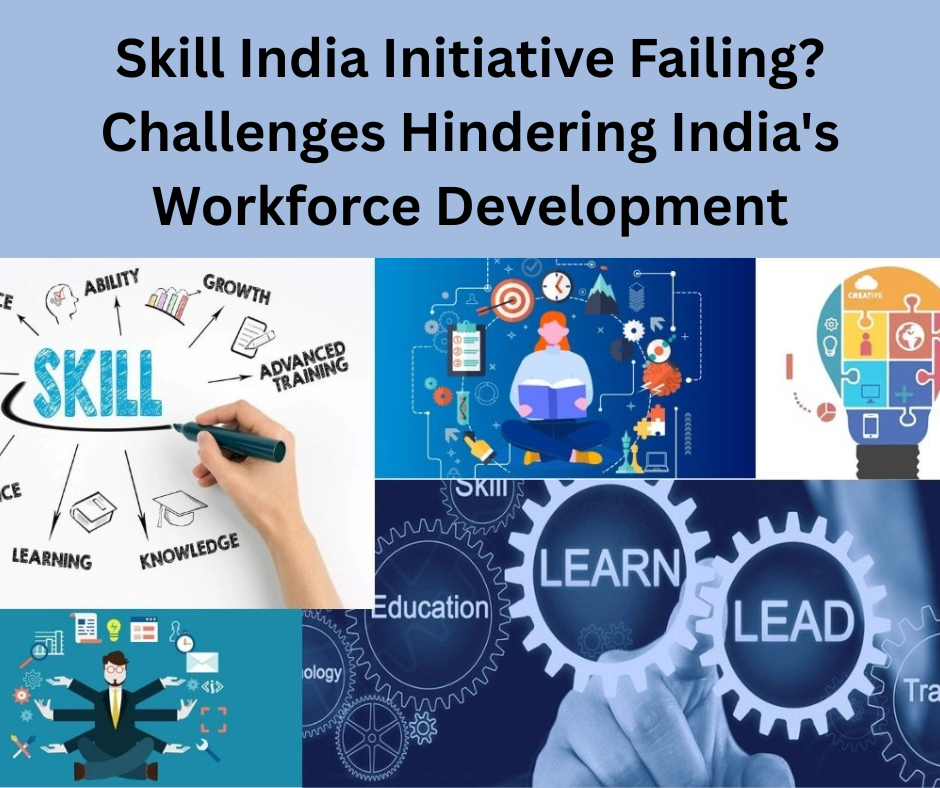Skill India Initiative: Challenges, Leadership Crisis, and the Way Forward
The Skill India Initiative was launched with the ambitious goal of equipping the Indian youth with industry-relevant skills to enhance employability and tap into the country’s demographic dividend. However, recent studies and developments reveal that the Skill India Initiative is not yielding the expected results. With employability rates as low as 22% among NSDC-funded training providers, there is growing concern about the efficiency and transparency of the program.
Skill India Initiative and Its Structural Framework
Under the Skill India Initiative, young individuals in India can pursue vocational education through five main avenues:
- Industrial Training Institutes (ITIs): Over 14,000 institutions, mainly privately managed.
- Vocational courses in secondary schools: Optional courses in classes 9 to 12.
- Government-funded short-term programs: Includes the Prime Minister’s Kaushal Vikas Yojana (PMKVY).
- Ministry-specific schemes: Like the Deen Dayal Upadhyaya Grameen Kaushalya Yojana under the Ministry of Rural Development.
- Apprenticeship programs: Often funded through public-private partnerships.
Among these, short-term training through private providers funded by the National Skill Development Corporation (NSDC) has gained traction. However, issues in leadership and financial governance have overshadowed its performance.
Leadership Crisis in NSDC
A major roadblock in the Skill India Initiative has been the instability in NSDC leadership. The positions of CEO and Chairperson remained vacant for years. Recently, the termination of Ved Mani Tiwari, the acting CEO, further emphasized the management disarray. Reports suggest that he was never formally appointed and appropriated the title without due process.
This leadership vacuum raises questions about the seriousness of efforts in leveraging India’s demographic dividend, especially in a rapidly changing global workforce influenced by artificial intelligence.
Financial Irregularities and Lack of Transparency
The NSDC, primarily funded through government allocations via the National Skill Development Fund, has spent over Rs 10,000 crore since its inception. However, its operational transparency remains questionable.
In 2015, the Comptroller and Auditor General (CAG) flagged several irregularities. Instead of improving, the situation deteriorated. In 2021, NSDC created a subsidiary, NSDC International, using public funds, but it is unclear whether this move was approved by the Cabinet. No financial reports or statements from NSDC International have been made public, raising serious concerns about accountability.
Weak Coordination and Duplication of Efforts
Despite spending heavily on tech platforms like ASEEM and the SMART portal, NSDC failed to develop a comprehensive Labour Market Information System (LMIS). Instead, the Ministry of Labour is now attempting to fill this gap via the National Career Service portal.
This duplication of efforts and fragmented coordination illustrate poor planning and communication within ministries and between central and state stakeholders.
Ground-Level Impact and Employability Crisis
The Skill India Initiative‘s on-ground performance has also been lackluster. Out of approximately 6,000 short-term training providers under PMKVY, only 22% of trainees reportedly found employment. This low employability rate reflects both inadequate curriculum design and insufficient industry engagement.
Moreover, with India’s demographic window rapidly shrinking (expected to close by 2040), the urgency to revamp skill development programs becomes more critical. Youths entering the labor market face new challenges brought on by automation and AI. If India fails to equip its young population with relevant skills, the consequences could be irreversible.
Misuse of Public Funds and Need for Oversight
Recent changes in NSDC’s financial accounting methods during Tiwari’s tenure have also drawn scrutiny. Experts suggest these changes may have been introduced to project a healthier financial performance.
With the 2025-26 Union Budget raising skill development allocations from Rs 20,000 crore to Rs 36,000 crore, it is crucial that funds are utilized transparently and efficiently. Institutions like NSDC must be held accountable, and their operations should be subject to regular audits.
Way Forward: Reform and Rebuild
To salvage the Skill India Initiative, the government must:
- Appoint competent and transparent leadership at NSDC.
- Enforce accountability through mandatory public disclosure of financial statements.
- Develop a unified Labour Market Information System to avoid redundancy.
- Ensure active industry participation in course design and implementation.
- Prioritize outcome-based training with real-world applicability.
- Facilitate better coordination between the Centre, states, and private training partners.
The vision behind the Skill India Initiative remains relevant and necessary. However, without immediate corrective action, India risks missing out on its most valuable asset – its youth. As the world of work evolves at an unprecedented pace, timely and strategic reforms are the only way to turn this initiative into a true national success story.
Read more: JEECUP Result 2025 Released

[…] Private School Admissions in A.P.: 8,583 Students Allotted Seats in Second Phase Skill India Initiative Failing? Challenges Hindering India’s Workforce Development Israel Claims Killing of Senior Iranian Commander Amid Escalating Cross-Border Strikes YSRCP […]
[…] Free Private School Admissions in A.P.: 8,583 Students Allotted Seats in Second Phase Skill India Initiative Failing? Challenges Hindering India’s Workforce Development Israel Claims Killing of Senior Iranian Commander Amid Escalating Cross-Border Strikes YSRCP […]
[…] Free Private School Admissions in A.P.: 8,583 Students Allotted Seats in Second Phase Skill India Initiative Failing? Challenges Hindering India’s Workforce Development Israel Claims Killing of Senior Iranian Commander Amid Escalating Cross-Border Strikes YSRCP […]